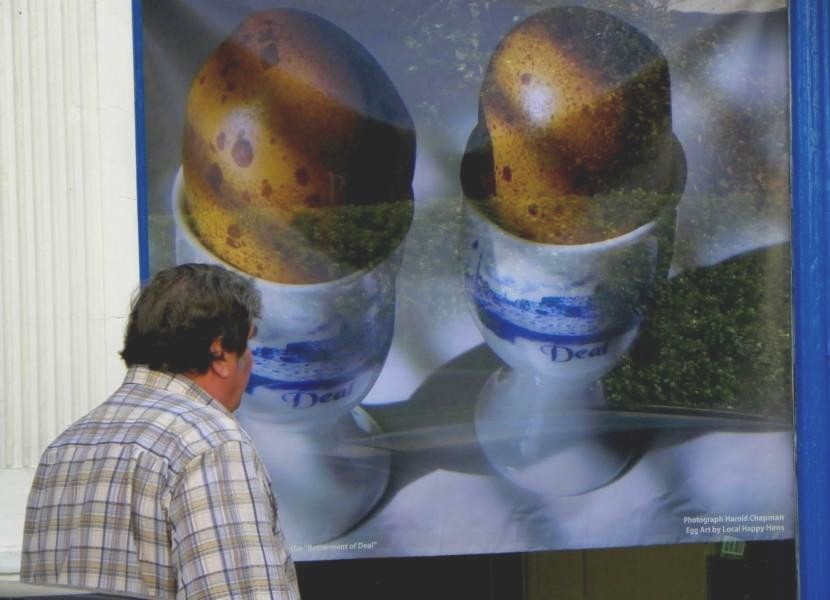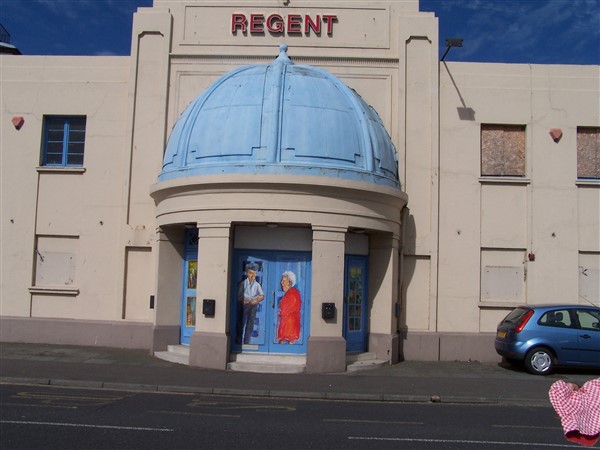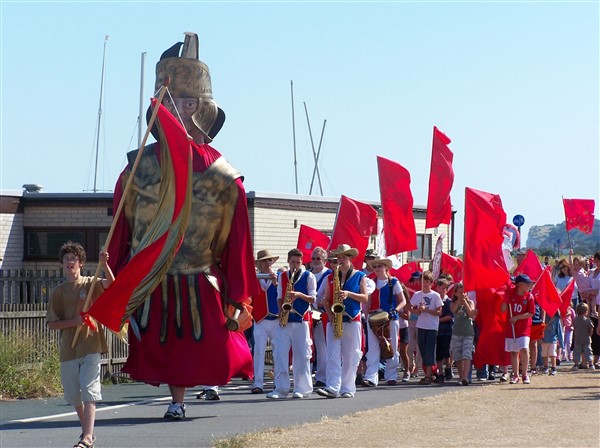Harold Chapman lived in Deal (1927-2022) . He was an iconic photographer for his narrative on social history. Best known for having lived in, photographed and written about "The Beat Hotel" in Paris, where William Burroughs and Alan Ginsberg lived and wrote in the 1950's.
Harold loved to talk to Artists and give advice. He told me that I should find something I liked and stick with it like glue.
This is excellent advice, but advice that I stood no chance at all of obeying. The reason, I think, is that Artists thrive on divergent thinking. If only artists were better at following through, focusing, working to a format or a theme, they would produce marketable goods. The only problem with this theory is that when a creative person has to think logically they often loose the thread of their creativity. Much of the commercial artworld thrives with these constraints, and they prefer artists to produce a small amount of product, which will drive prices up.
You have to decide is this a system that you embrace, or do you feel shackled by it. You don't have to work this way.
The photograph below is by Harold Chapman, featuring what he felt was an essential part of British Life:
Harold loved to talk to Artists and give advice. He told me that I should find something I liked and stick with it like glue.
This is excellent advice, but advice that I stood no chance at all of obeying. The reason, I think, is that Artists thrive on divergent thinking. If only artists were better at following through, focusing, working to a format or a theme, they would produce marketable goods. The only problem with this theory is that when a creative person has to think logically they often loose the thread of their creativity. Much of the commercial artworld thrives with these constraints, and they prefer artists to produce a small amount of product, which will drive prices up.
You have to decide is this a system that you embrace, or do you feel shackled by it. You don't have to work this way.
The photograph below is by Harold Chapman, featuring what he felt was an essential part of British Life:
Brief talk about art by Penny Bearman
(for Deal Arts Club at the Bohemian, Tuesday 2nd September 2025)
The brief for this event is "how to show your work to the public in an exhibition" I apologise now for my diverging ideas.
(for Deal Arts Club at the Bohemian, Tuesday 2nd September 2025)
The brief for this event is "how to show your work to the public in an exhibition" I apologise now for my diverging ideas.

When Deal was suffering from the nation wide recession in 2008 that hit High Streets particularly badly, many of our shops closed, and many of them were boarded up by the Landlords who had no hope of re-letting and wanted to avoid vandalism. I was really worried about what harm this would do to Deal and decided to put paintings on the wooden hoardings.
I couldn't find other artists who were prepared to paint spontaneously, and for little or no remuneration, but I did persuade a large number to let me have a large format image. I worked with the wonderful Jane Langstaff and Stephanie Hayman who secured a Regeneration grant to pay for a sign company to print artworks on to blinds to fill shop windows before they were boarded up.
I couldn't find other artists who were prepared to paint spontaneously, and for little or no remuneration, but I did persuade a large number to let me have a large format image. I worked with the wonderful Jane Langstaff and Stephanie Hayman who secured a Regeneration grant to pay for a sign company to print artworks on to blinds to fill shop windows before they were boarded up.
I have spent most of my life precisely ignoring Harold Chapman's advice. I realised, especially when working on the many murals over the years, that the greatest satisfaction is achieved by the unexpected, and an Artist's best work is often not museum conservation grade, and often has a short shelf-life. Some of the work that is wilfully destroyed sparks nostalgia, precisely because it lives on only in the memory.
So, after having reached retirement age, and having brought up 3 children and bought a house and having managed to drive myself and them around in cars...the usual expensive trappings of the present day...all things that I never expected to achieve if I insisted on making a living as an artist. I feel that foolhardy as my approach seems, it provided a lifestyle that struck some kind of balance between commercialism and artistic fulfilment.
So, after having reached retirement age, and having brought up 3 children and bought a house and having managed to drive myself and them around in cars...the usual expensive trappings of the present day...all things that I never expected to achieve if I insisted on making a living as an artist. I feel that foolhardy as my approach seems, it provided a lifestyle that struck some kind of balance between commercialism and artistic fulfilment.

Weirdly, the wall paintings from this period helped me make a living. Although I did them as an expression of my deep love for a town that had given me a home, and I felt a strong feeling of doing the right thing in the right place at the right time, I was unwittingly marketing myself and putting myself out in the public.
I started running galleries as a direct consequence of doing the Deal murals, when I was offered a shop initially free of charge. It was a huge shock to me that paintings I hung in the window sold. It was only this that led to multiple other gallery projects.
I started running galleries as a direct consequence of doing the Deal murals, when I was offered a shop initially free of charge. It was a huge shock to me that paintings I hung in the window sold. It was only this that led to multiple other gallery projects.
In answer to some of the questions offered to me as part of this brief: Firstly on curation,
I believe that Artists are natural curators, so don't be frightened, but it is necessary to find your style of curation, without being too aware of the advice you're given!
For example, when I'm painting I like to put a warm colour in the middle, to prevent too much depth from appearing in the painting in too obvious a place, which means that you have to move your eye left and right to seek the depth. Not all or even many painters think like this. Ivon Hitchens puts the greater tonal breadth in the middle, once again to make the painting spark in the middle but not necessary providing depth. The left and right have just light and middle tones, or middle and light, allowing a gentler reading of the space.
So, why not curate your shows as you would your paintings.
I've been curating mixed shows as well as my own for years, putting the hot colour centre stage, cooler ones beside.
In a gallery you begin to realise that there are "hot spots" where pictures in that position frequently sell. You need to put your best work here, perhaps where the lighting is best, or where people feel comfortable sitting or standing.
Pricing: put ambitious prices on some of your work, preferably the loose, ambitious pictures, even if you don't like them. Price the well-thought out perfect pictures a bit cheaper than this, so that people feel lucky to get your best work for a discount.
Lastly, don't connect the effort you make with the price tag, I know that's the union line, and the advice you're given, but you should disconnect money from art wherever possible. Sell things cheaply if you feel like it, or expensively if you feel like it. It all evens out in the end, its better to sell than not sell, and its good for your soul to move on and not be too precious about it.
Its your job as an artist to get your work out there, circulate it as much as possible. Record every person's detail who say anything nice, to invite them to your events. They are your most precious resource.
Hanging: buy yourself a universal system that can be adapted for most galleries so that you can curate easily and quickly.
STAS is a brilliant and cheap system. Find them online.
CREATE YOUR OWN WEBSITE Don't let anyone do it for you,
you'll never be able to keep it updated if you don't. You can communicate with the world if you can fight tech.fobia.
Cards...yes! And the most important part is the web site on the back, don't worry about the price you charge for cards, they are your advertising.
I believe that Artists are natural curators, so don't be frightened, but it is necessary to find your style of curation, without being too aware of the advice you're given!
For example, when I'm painting I like to put a warm colour in the middle, to prevent too much depth from appearing in the painting in too obvious a place, which means that you have to move your eye left and right to seek the depth. Not all or even many painters think like this. Ivon Hitchens puts the greater tonal breadth in the middle, once again to make the painting spark in the middle but not necessary providing depth. The left and right have just light and middle tones, or middle and light, allowing a gentler reading of the space.
So, why not curate your shows as you would your paintings.
I've been curating mixed shows as well as my own for years, putting the hot colour centre stage, cooler ones beside.
In a gallery you begin to realise that there are "hot spots" where pictures in that position frequently sell. You need to put your best work here, perhaps where the lighting is best, or where people feel comfortable sitting or standing.
Pricing: put ambitious prices on some of your work, preferably the loose, ambitious pictures, even if you don't like them. Price the well-thought out perfect pictures a bit cheaper than this, so that people feel lucky to get your best work for a discount.
Lastly, don't connect the effort you make with the price tag, I know that's the union line, and the advice you're given, but you should disconnect money from art wherever possible. Sell things cheaply if you feel like it, or expensively if you feel like it. It all evens out in the end, its better to sell than not sell, and its good for your soul to move on and not be too precious about it.
Its your job as an artist to get your work out there, circulate it as much as possible. Record every person's detail who say anything nice, to invite them to your events. They are your most precious resource.
Hanging: buy yourself a universal system that can be adapted for most galleries so that you can curate easily and quickly.
STAS is a brilliant and cheap system. Find them online.
CREATE YOUR OWN WEBSITE Don't let anyone do it for you,
you'll never be able to keep it updated if you don't. You can communicate with the world if you can fight tech.fobia.
Cards...yes! And the most important part is the web site on the back, don't worry about the price you charge for cards, they are your advertising.

Roman invasion by Loose Cannon, my community group designed to reach out between the different branches of the arts and local heritage/history.
Once again, not a very sensible way to make a living on the face of it, but the awards for all Big Lottery grant we applied for paid for equipment to run related art classes, which morphed into Artlark, a teaching project still running today. Artlark found Bill Cameron Ward, a very lateral thinking Artist, who dreamt up the idea of Deal Arts Club here at the Bohemian.
What would we do without Bill and divergent thinkers!
LINKS: DEAL MURALS
PENNY BEARMAN HOME PAGE
CONTACT
Once again, not a very sensible way to make a living on the face of it, but the awards for all Big Lottery grant we applied for paid for equipment to run related art classes, which morphed into Artlark, a teaching project still running today. Artlark found Bill Cameron Ward, a very lateral thinking Artist, who dreamt up the idea of Deal Arts Club here at the Bohemian.
What would we do without Bill and divergent thinkers!
LINKS: DEAL MURALS
PENNY BEARMAN HOME PAGE
CONTACT